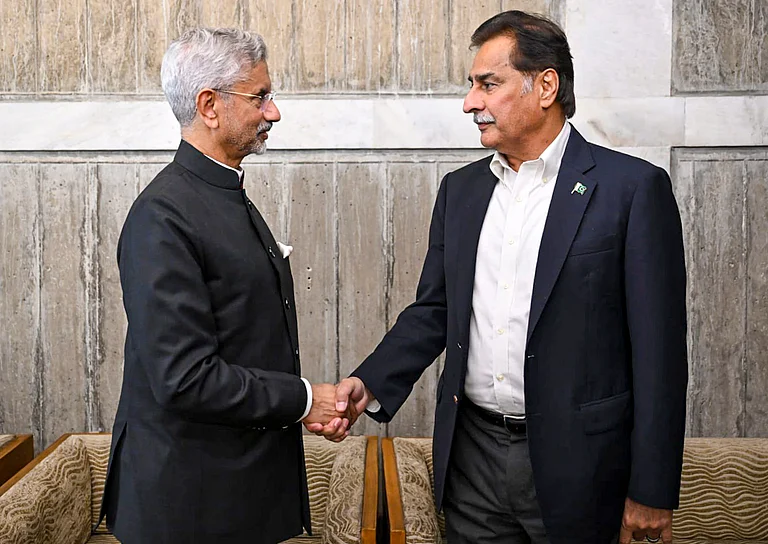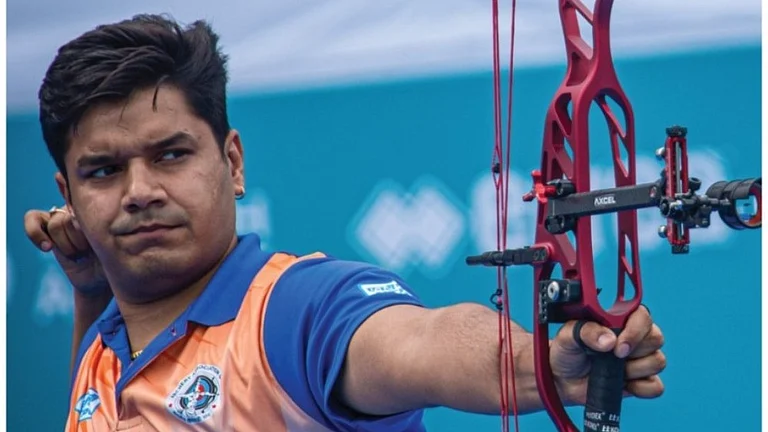On January 24, 1950, the day the Hindi version of the first stanza of a Bengali song composed by Rabindranath Tagore was adopted as India’s national anthem, Dr Rajendra Prasad, the first president, told the Constituent Assembly that it was “subject to such alterations in the words as the government may authorise as occasion arises”. Sixty-eight years later, there’s indeed a debate over one of the words in the anthem—Sindh, a land that no longer belongs to the country. Earlier this year, Ripun Bora, a Congress MP from Assam, moved a private member’s resolution in the Rajya Sabha seeking to replace “Sindh” with “Northeast”. But Jaipur-based Bhagwan Atlani, a 73-year-old Sindhi writer and former chairperson of Rajasthan Sindhi Academy, believes it can’t happen. “Sindh has been there and it will remain there. Let them shout, nothing will change,” he says.
Atlani was three in 1948 when a pogrom forced Hindus in Sindh, a state in newly formed Pakistan, to seek refuge in India. His family had to leave their home in uptown Larkana and board a steamer from Karachi. Like thousands of Sindhi families, they ended up at the Kalyan-Ulhasnagar camp on the outskirts of Bombay (now Mumbai) and had to start their lives from scratch. That’s how the Indian population came to include a community that carries the name of a state across the border as one of its many legacies. Relatively untouched—unlike the Bengalis and the Punjabis—by the violence that accompanied Partition, the Sindhi Hindus now found themselves in a country that didn’t include Sindh. Sindhi speakers in India numbered around 25 lakh in 2001, when the population of India was around 100 crore, according to that year’s census.
“The community chose to downplay their culture, language and identity after Partition. They would learn the local language of the places they settled in,” says Nandita Bhavnani, author of The Making of Exile: Sindhi Hindus and the Partition of India. Without the hope of ever returning to their homes, they embraced not just the language and traditions of the places they migrated to, but adopted their food habits as well. “When I interviewed people whose families settled in Gujarat after Partition, they told me neighbourhood kids would often refuse to play with them as they ate non-vegetarian food. So the families turned vegetarian just to gain social acceptance,” says Bhavnani.
A linguistic minority, the Sindhis are struggling to hold on to their language as it gradually loses its resonance, and perhaps, even relevance among the youth, who can barely hold a conversation in their native tongue. The government recognises both the Perso-Arabic and Devanagari variants of the Sindhi script. But as the Centre-run Sahitya Akademi recognises only a single script for every Indian language, it’s Perso-Arabic for Sindhi.
“So only those who write in the original Perso-Arabic script, which has a standardised vocabulary, qualify for awards,” says Atlani. “A major problem with Sindhi written in Devanagari is there’s no standardisation of the script. Wherever the Sindhis stayed, the local language influenced the pronunciation of Sindhi words, so what I write in Devanagari Sindhi today might be right or wrong—there’s nobody to judge that. And what could be the basis of that judgement?” Consequently, young writers mostly acquainted with the newly minted Devanagari script feel discouraged from pursuing a career in Sindhi literature due to a lack of state patronage.
The language spoken by a community is intrinsically related to its identity, and for the Sindhis in India, a threat to their native tongue has posed a challenge to the fundamentals of their existence. With a gradually dwindling population of Sindhi speakers and writers in the country, the current generation experiences a sense of alienation from their roots. A part of this may be attributed to the rapidly disappearing Sindhi medium schools and Sindhi language courses from institutions in India.
“The only identity that the Sindhis have in the country today is their language. Whatever else we want to claim would have been claimed before us by the local people of the region we have settled in,” says Sindhi poet Vimmi Sadarangani, a professor of the language at Tolani College of Arts and Science in Adipur, in Gujarat’s Kutch region. Adipur is one of the towns that had been designated to house refugees from Sindh during Partition.
The scholar fondly remembers her introduction to the fascinating world of literature in her mother tongue when she was in the eighth standard, and had just moved to a school that offered Sindhi as one of its subjects. After pursuing postgraduation in economics, Sadarangani says she could no longer resist exploring the vast richness of Sindhi literature. “I went on to do an MA and PhD in Sindhi and have been teaching the language for 23 years. But the current generation does not think learning the language is profitable. Of the 550 students in my college, only five have taken up Sindhi,” she says.

A Sindhi language class in progress at a Mumbai college
Vishu Bellani, professor of Sindhi in Delhi University’s Deshbandhu College, shares this concern over the declining interest in Sindhi. Originally from Ajmer, the 65-year-old is preparing to retire, rather reluctantly, from what seems to be the last teaching position for Sindhi in the university, at least for some time to come. “I know how I have singlehandedly managed for 40 years. I hope the university finds a replacement in the next six months so the students aren’t stranded midway like this,” says Bellani.
The fact that Sindhis—now one of the most affluent business communities in India—run numerous schools and colleges across India has not prevented their language from facing rejection at premiere institutions. Sindhi writers and artistes have gradually been reduced to one-man shows who self-publish and distribute their own work. “We write, publish, circulate and read our own books. There’s no publisher or bookstore for our books. Can you imagine what that feels like?” says Sadarangani.
“Sufism is inherent in the outlook of the Sindhi community and enables a stoic acceptance of reality,” says Saaz Aggarwal, author of Sindh: Stories from a Vanished Homeland. Their peculiar situation of being foreigners to the land associated with their language has ensured that success in business did not help the Sindhis consolidate the vibrant and age-old legacy of the community in India. “We were the sacrificial goats during Partition. We could easily have been given three districts from Gujarat, but that never happened. It’s impossible to have a future without land,” says Sahitya Akademi awardee Lakhmi Khilani, one of the founders of the Indian Institute of Sindhology in Adipur. Not a single Sindhi writer has been conferred with the prestigious Jnanpith Award in literature till date.
The performing arts have followed suit, with Sindhi cinema, dance and music falling prey to a fast eroding bank of cultural riches. As stories are being written by a handful of budding talents, they need to be adapted into forms that can be performed and not just read, as few in the current generation can follow the script. “We need to do ‘cool’ things to get the youth interested in Sindhi culture,” says 21-year-old Dirven Hazari from Ulhasnagar, who runs a YouTube channel named ‘Sindhionism’ for exclusively Sindhi content. With a growing tribe of followers, currently over 71,000, Hazari’s success crossed a milestone last year when Sindhionism got shortlisted by YouTube as one of its 12 finalists for YouTube NextUp, an annual interactive event conducted by the video-hosting giant that brings together promising content creators.
“In 2017 we made the world’s first Sindhi web series called Two Nights Three Days. It’s about the kind of pressure faced by students during exams,” Hazari says. The young YouTuber admits not having any interest in his language and culture until two years ago, when he saw some social media posts accusing the Sindhi youth of being uninterested in their histories.
“There are very few with the drive needed to save our culture,” says Mumbai-based Sindhi singer, Kaajal Chandiramani, whose body of work spans over 30 years and more than 10,000 shows. And yet, only a handful in the current generation seem to have heard of her. “Nothing is being done in Sindhi now. When I started, there were such good composers, poets and lyricists. Now, people only perform the same songs they were singing 30 years ago. Since nobody knows the language today, the new generation doesn’t even know me. People only want Bollywood songs. They want to dance to ‘Baby doll main sone di’,” the singer sighs.
Additionally, the performing arts in Sindhi are totally deprived of state patronage in the form of awards. To this day, there’s only the Sindhi Sahitya Akademi, which honours works of literature alone “The Maharashtra Akademi, the Gujarat Akademi, the Sindhi Akademi or the National Council for Promotion of Sindhi Language...nobody gives awards to performing artistes,” says Anila Sunder, 67-year-old choreographer of Sindhi ballets. “We are invited to perform when others are winning awards, but we never receive them.”
As the global Sindhi citizen from India continues to travel and settle all over the world, the community back home carries on fighting for a secure platform to showcase its legacies. Sindhi entrepreneur Asha Chand has been petitioning for an exclusively Sindhi television channel in India since 2007. “A channel is quite important for learning the language and giving the artistes a platform,” says Chand, who runs the Mumbai- and Dubai-based NGO, Sindhi Sangat. “You can learn a language only when you speak and hear it. If there’s a programme on a channel, people will pick up Sindhi words from it.”
As the government-funded coffers for the Sindhi arts start to run dry, artistes from the community have begun to express their disappointments through their performances. Kishen Ramnani, a 40-year-old theatre actor from Ulhasnagar, has been associated with the stage for over two decades. He says one is compelled to pursue Sindhi theatre as their passion, and not profession, as the stage provided by the state isn’t enough to sustain them. “Where is the stage? Where is the support? That is what we ask in our upcoming video,” says Ramnani.
Jeetu Vazirani, a Sindhi actor often spotted in Hindi shows like C.I.D. and in minor roles in films such as Om Jai Jagadish, shares the sentiments of fellow artistes from his community. Having worked in five Sindhi films and around 15 Sindhi telefilms produced by Asha Chand, Vazirani believes acting in his mother tongue has been an effective launchpad for his career in the Hindi entertainment industry. “Hindi serials are my bread and butter, but Sindhi actors are gradually gaining a footing in India, especially in the past 10 years. We won’t stop working until we are able to fully sustain ourselves by doing work only in Sindhi,” says the artiste. Sindhi films in India are mired in funding and distribution issues, as no theatre can guarantee them a profitable run.
“It’s unfortunate that most Sindhi youngsters don’t speak the language anymore. It’s difficult to convert Sindhis into a linguistic majority,” says veteran lawyer and politician Ram Jethmalani. One may have been tempted to use the word “impossible” in such a situation, but for a community of iron-willed survivors like the Sindhis of India, a difficult feat is perhaps never too impossible to achieve.


























